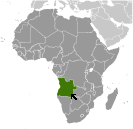World Atlas: Angola. On this page you can see the map, country flag and many detailed information about the people, history and economy of Angola.

Here you can find online selected information about the geography, inhabitants, government, economy and history of Angola. Included are selected statistics, an overview map and the detailed map of Angola. But let's start with the flag of Angola here:
Angola - Overview:
What you should know about Angola? Let's start with this: Angola scores low on human development indexes despite using its large oil reserves to rebuild since the end of a 27-year civil war in 2002. Fighting between the Popular Movement for the Liberation of Angola (MPLA), led by Jose Eduardo DOS Santos, and the National Union for the Total Independence of Angola (Unita), led by Jonas Savimbi, followed independence from Portugal in 1975. Peace seemed imminent in 1992 when Angola held national elections, but fighting picked up again in 1993. Up to 1.5 million lives may have been lost - and 4 million people displaced - during the more than a quarter century of fighting. Savimbi's death in 2002 ended Unita's insurgency and cemented the MPLA's hold on power. President DOS Santos pushed through a new constitution in 2010 and was elected to a five year term as president in 2012.
Geography of Angola
 Where on the globe is Angola? The location of this country is Southern Africa, bordering the South Atlantic Ocean, between Namibia and Democratic Republic of the Congo. Total area of Angola is 1,246,700 sq km, of which 1,246,700 sq km is land. So this is very large country. How could we describe the terrain of the country? This way: narrow coastal plain rises abruptly to vast interior plateau. The lowest point of Angola is Atlantic Ocean 0 m, the highest point Moca 2,620 m. And the climate is semiarid in south and along coast to Luanda; north has cool, dry season (May to October) and hot, rainy season (November to April).
Where on the globe is Angola? The location of this country is Southern Africa, bordering the South Atlantic Ocean, between Namibia and Democratic Republic of the Congo. Total area of Angola is 1,246,700 sq km, of which 1,246,700 sq km is land. So this is very large country. How could we describe the terrain of the country? This way: narrow coastal plain rises abruptly to vast interior plateau. The lowest point of Angola is Atlantic Ocean 0 m, the highest point Moca 2,620 m. And the climate is semiarid in south and along coast to Luanda; north has cool, dry season (May to October) and hot, rainy season (November to April).
Inhabitants of Angola
Let's take a look how many people live in Angola. The number is: 29,310,273 (July 2017 est.). So quite a lot people live here. Who lives here? Ovimbundu 37%, Kimbundu 25%, Bakongo 13%, mestico (mixed European and native African) 2%, European 1%, other 22%. What are the languages in Angola? Portuguese 71.2% (official), Umbundu 23%, Kikongo 8.2%, Kimbundu 7.8%, Chokwe 6.5%, Nhaneca 3.4%, Nganguela 3.1%, Fiote 2.4%, Kwanhama 2.3%, Muhumbi 2.1%, Luvale 1%, other 3.6%. And the religions: Roman Catholic 41.1%, Protestant 38.1%, other 8.6%, none 12.3% (2014 est.). How old are the people in average? 15.9 years. We have to add that this number is the median - so one half of the people is older than this, one half is younger. And what is their life expectancy (at birth)? This: 60.2 years. Where the people live in Angola? Here: most people live in the western half of the country; urban areas account for the highest concentrations of people, particularly Luanda. The major urban areas of Angola are: Luanda (capital) 5.506 million; Huambo 1.269 million (2015).
Government and Economy of Angola
The capital of Angola is Luanda and the government type presidential republic. Let's take a look at the administrative divisions - 18 provinces (provincias, singular - provincia); Bengo, Benguela, Bie, Cabinda, Cunene, Huambo, Huila, Kwando Kubango, Kwanza Norte, Kwanza Sul, Luanda, Lunda Norte, Lunda Sul, Malanje, Moxico, Namibe, Uige, Zaire. Regarding the economy of Angola, important industrial products are petroleum; diamonds, iron ore, phosphates, feldspar, bauxite, uranium, and gold; cement; basic metal products; fish processing; food processing, brewing, tobacco products, sugar; textiles; ship repai. Important agricultural products are bananas, sugarcane, coffee, sisal, corn, cotton, cassava (manioc, tapioca), tobacco, vegetables, plantains; livestock; forest products; fish. The most important export commodities are crude oil, diamonds, refined petroleum products, coffee, sisal, fish and fish products, timber, cotton and the most important export partners are China 53.7%, India 7.6%, US 5.6%, South Africa 5.3%, France 4.4% (2016). The most important import commodities are machinery and electrical equipment, vehicles and spare parts; medicines, food, textiles, military goods and the most important import partners are Portugal 15.9%, US 12.5%, China 12.2%, South Africa 6.8%, Belgium 6.3%, Brazil 5.5%, UK 4.3% (2016). How rich is Angola and how rich are people in this country? The most important number here is GDP per capita (PPP): $6,800 (2017 est.). This is quite a low number. Let's add that this means Gross Domestic Product per person, which is recalculated with respect to the relative cost of local goods and services. And one more important number - population below poverty line: 40.5% (2006 est.).